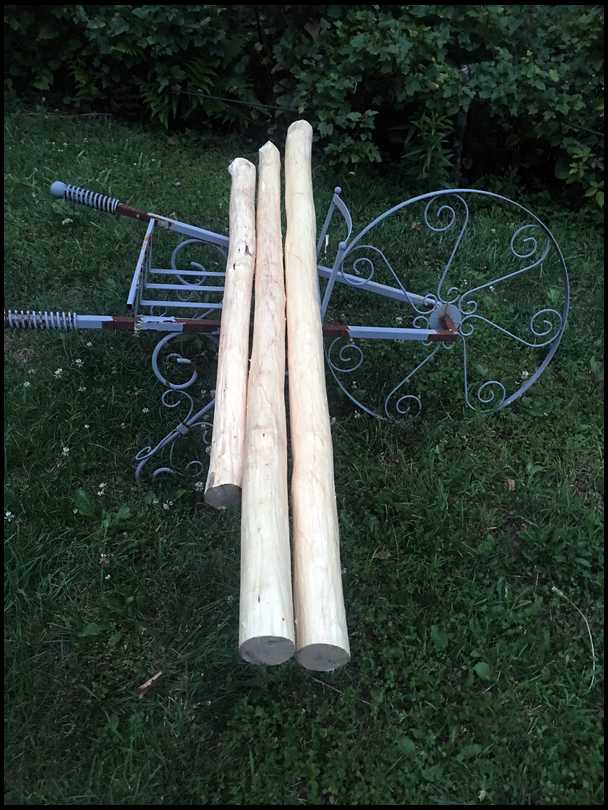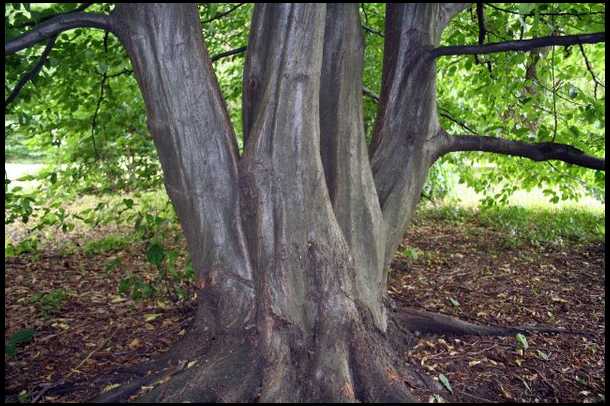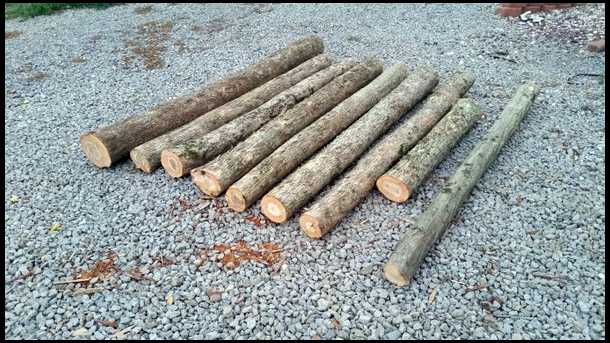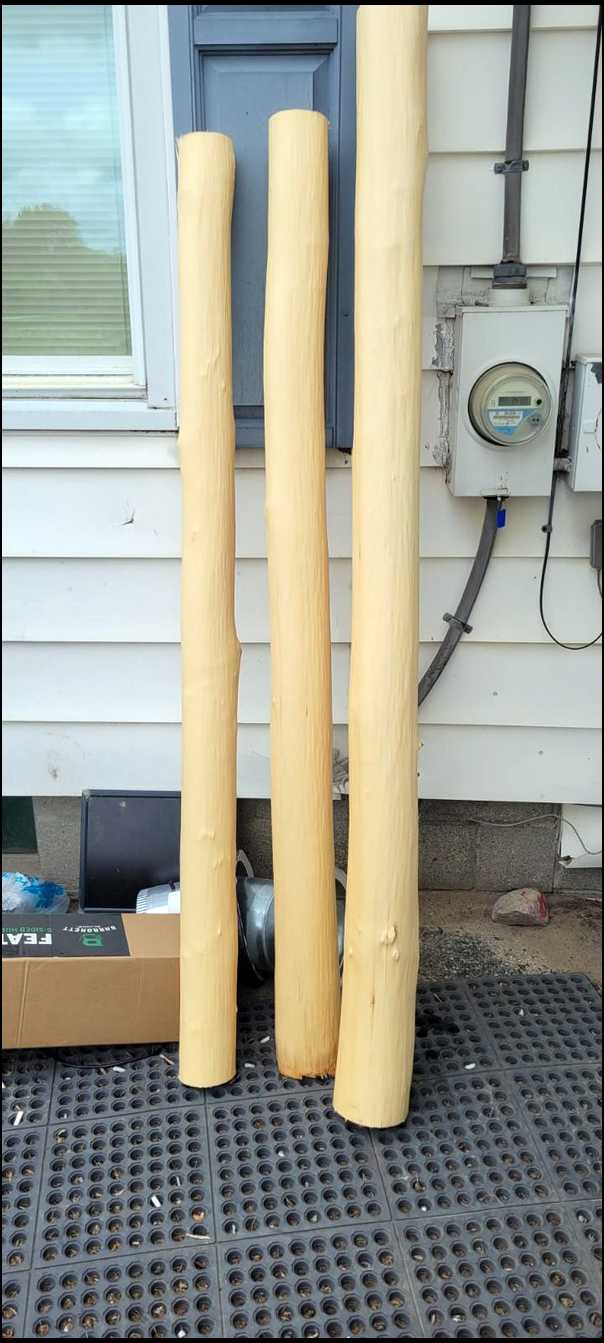| From: Arrowhead
|
|
|
|
|
|
|
| Date: 12-Nov-22 |
|
I've never worked with or seen this wood. Is the growth rings tight or can you get it with wide growth rings? I like making snakey osage bows but having tough time finding good staves. Where can I get hop hornbeam?
|
|
| From: Runner
|
|
|
|
|
|
|
| Date: 12-Nov-22 |
|
It's likely in your woods. It almost always has fine growth rings. Even trees with wider growth rings are still relatively fine.
The wood is about like a cross between Hickory and Maple.
|
|
| From: Bassmaster
|
|
|
|
|
|
|
| Date: 12-Nov-22 |
|
It is in the birch family, but different genus. I too could not locate it in my neck of the woods, but last year a friend gifted me with 2 logs. It gets high marks as a bow wood. I have made some bows with it, but much more experienced with blue beech which is also called horn beam in one form ,or another, and of the two woods I still prefer the blue beech although most don't.
|
|
| From: Tom Litchfield
|
|
|
|
|
|
|
| Date: 14-Nov-22 |
|
My Dad always called it "ironwood". It is common in northeastern Iowa. You should have it in MN but it may be mostly restricted to eastern MN. It is almost always an understory tree, the scientific name is Ostrya virginiana and its "official" common name is Eastern Hophornbeam. If you search for it online you will find photos of it. It is typically a small tree.
I commonly find it growing in the understory of mature oak/hickory stands or the understory of maple/basswood stands. It is shade tolerant and usually grows pretty slow. It is too late for leaves now but sometimes younger saplings will retain the tan/brown leaves for quite a while. The bark has fine flakes (rubbing your hand on the bark will displace small pieces the size of chainsaw dust) and is brownish/gray. The bark is distinctive once you develop an eye for it. A big one will be 12" or more in diameter but 4" to 10" are the sizes I typically see.
Where I grew up, blue beech was also called musclewood and it has an "official" common name of American Hornbeam. It is also a small understory tree with thin, gray/brown bark that is not flaky. The growth form makes it look skin (the bark) stretched over muscles (the wood). It should be in MN too but it should not be as widespread as Eastern Hophornbeam & typically a 4" to 6" musclewood would be considered "big".
|
|
| From: Arrowhead
|
|
|
|
|
|
|
| Date: 14-Nov-22 |
|
Thanks guys. I'll go on line and see if I can find some pi pictures of it and go from there. Thanks again.
|
|
| From: Bassmaster
|
|
|
|
|
|
|
| Date: 14-Nov-22 |
|
Tom... your description is right on. I finished, and shot one today. I had trouble with belly frets on a couple, but I got this one right. I made it wider ,and trapped the back. Shoots good, and will go to the friend that gifted me the logs.
|
|
| From: hunterbob
|
|
|
|
|
|
|
| Date: 15-Nov-22 |
|
I always liked the wood just pop the bark off and lay out your bow.
|
|
| From: Mechanic
|
|
|
|
|
|
|
| Date: 15-Nov-22 |
|

Tightly grained and very fine thin rings, no need to chase rings. If you cut it in the spring or summer, the bark just slips off and that’s your backing. I like the wood but it’s hard work drawing the wood because fibers interlock.
|
|
| From: Bassmaster
|
|
|
|
|
|
|
| Date: 15-Nov-22 |
|
Yep, not easy wood to work with, and once heating the wood to straighten limbs ,and twist it wants to go back to it's original shape. Not near as ductile as some other woods, and I had to make the bow over all wider than some white woods that I use, and trap the back to prevent belly fretting. If it all turns out alright though it makes a good shooting bow that has snap.
|
|
| From: Jeff Durnell
|
|
|
|
|
|
|
| Date: 15-Nov-22 |
|
My experience differs. I don't have problems with it fretting. I make it narrower than other white woods, somewhere between them and osage, fully radiused bellies, don't trap it, and over 60# too, no problem. HHB is my favorite white wood.
|
|
| From: Bassmaster
|
|
|
|
|
|
|
| Date: 15-Nov-22 |
|
I didn't radius the belly. That is faucet tillering, and not so good for beginning bow makers in my opinion. I differ with you, also in that it does not split easily,or straight, and it is hard working with a draw knife, and it is not very ductile, and trapping never hurts on white wood bows. Their all stronger in tension than compression. I have no problems now with fretting either now that I know the wood. Beginning bow makers can follow your lead,or mine, and come out with same results. I just think that it is easier my way for the beginner,so we can agree to disagree. As far as favorite white wood it may be yours ,but it is not mine, and every one on here can decide for themselves which methods will work best for them when working with this wood.
|
|
| From: Mechanic
|
|
|
|
|
|
|
| Date: 15-Nov-22 |
|
I think HH lends itself well to the holmgaard design, wide limbs/ narrow tips. I find it difficult to draw it out because all the staves I had dealt with had some spiraling to them.
|
|
| From: Jeff Durnell
|
|
|
|
|
|
|
| Date: 15-Nov-22 |
|
I got lucky and found a much higher percentage than normal with straight grain on my buddy's place. They split straight. They were dang good size trees too.. for HHB. I won't touch HHB if it has any propeller to it.
I've taught a lot of beginners the faceted tillering method, they were fine with it. In fact, that may be the best time to teach it, in the beginning.
Yes, it can be hard working HHB with a draw knife, especially if it's not green & wet. It earns its name Ironwood. I don't use a drawknife on it hardly ever.
I'm not telling anybody what to do. Just putting my opinions out there. And I agree Bassmaster, all experienced opinions and options are good to consider.
|
|
| From: bodymanbowyer
|
|
|
|
|
|
|
| Date: 15-Nov-22 |
|
It sure seems and sounds like Jeff D knows what he's talking about. I've seen a couple of his bows, I would take his knowledge and do what he says. JF
|
|
| From: Jeff Durnell
|
|
|
|
|
|
|
| Date: 15-Nov-22 |
|
I agree with some of what Bassmaster said... and some things I disagree with. No biggie. I'm not discounting his experience.
There's more than one 'right way' to make a bow with any given wood.
|
|
| From: George Tsoukalas
|
|
|
|
|
|
|
| Date: 15-Nov-22 |
|
Yes Jeff does know his stuff. HH does not grow in my land but I've been gifted some HH staves. I like it.
I make flat bellied bows or at least as flat as hand tools allow. Keeping in mind that hand tools work best with slightly radiused bellies.
I've never seen it for sale.
Jawge
|
|
| From: Stickbow Felty
|
|
|
|
|
|
|
| Date: 15-Nov-22 |
|
I have been working a hhb with a draw knife. It's rough going.Wish i had some osage.
|
|
| From: Stickbow Felty
|
|
|
|
|
|
|
| Date: 15-Nov-22 |
|
I have been working a hhb with a draw knife. It's rough going.Wish i had some osage.
|
|
| From: Runner
|
|
|
|
|
|
|
| Date: 15-Nov-22 |
|
I just use a sharp hatchet and rasp. HHB is also tough enough to straightline staves that have slight spiral or snaky grain.
It can split in any of a number of ways. As clean as Maple or tangled as Elm and everything in between.
|
|
|
|
| From: Eric Krewson
|
|
|
|
|
|
|
| Date: 15-Nov-22 |
|

American hornbeam AKA blue beech or muscle wood.
|
|
| From: Bassmaster
|
|
|
|
|
|
|
| Date: 15-Nov-22 |
|
Good pics of the 2 different trees.
|
|
| From: Bassmaster
|
|
|
|
|
|
|
| Date: 15-Nov-22 |
|
I have made quite a few bows from the bottom example from saplings (blue beech ). I sinew backed many of them. Makes a nice bow. Good elasticity.
|
|
| From: Jeff Durnell
|
|
|
|
|
|
|
| Date: 15-Nov-22 |
|

Here's another. The one on the right is Hornbeam(musclewood). The others are Hophornbeam.
|
|
| From: Bassmaster
|
|
|
|
|
|
|
| Date: 15-Nov-22 |
|
Are you using that wood for your signature lam bows more than self bows?
|
|
| From: Jeff Durnell
|
|
|
|
|
|
|
| Date: 15-Nov-22 |
|
99% of it is used for selfbows, Bob.
While processing logs for staves, I keep an eye out for sidetrims, leftovers and such that can be used to make backed bows. As much as I like boo backed bows, I generally won't sacrifice, or even risk, a prime selfbow stave.
|
|
| From: Jeff Durnell
|
|
|
|
|
|
|
| Date: 15-Nov-22 |
|
That said, I HAVE done it with hickory and maple. That is... make lumber the priority, and staves secondary.
The last two big smooth bark hickory logs I took to my buddy's sawmill, I cut as much as I could into quartersawn planks. I wanted it for backing strips and arrow wood. But if you're careful and watch for them, and stop cutting at the right time, you'll still end up with several good selfbow staves, which I did.
Man, I love cuttin wood.
|
|
| From: Bassmaster
|
|
|
|
|
|
|
| Date: 16-Nov-22 |
|
I used to, but at 75 soon I look for saplings now.
|
|
| From: Jeff Durnell
|
|
|
|
|
|
|
| Date: 16-Nov-22 |
|
That's kind of why I'm stocking up while I'm able. So if/when I retire, I won't have to cut any trees or buy it and will have plenty to work with. If I die before that, they can heat the house with it or just have a big bonfire.
|
|
| From: Tom Litchfield
|
|
|
|
|
|
|
| Date: 16-Nov-22 |
|
Great photos Eric. That American hornbeam is larger than any I have ever seen.
|
|
| From: Arrowhead
|
|
|
|
|
|
|
| Date: 22-Nov-22 |
|
Erik what is the diameter of that ironwood tree trunk? I think I finally found some out in the woods. The bark looks like it might be the same. I would say the diameter is 10"+ from what it sounds like that's to big and it must be 40' tall. Its mixed in with big oak trees.
|
|
| From: Jeff Durnell
|
|
|
|
|
|
|
| Date: 22-Nov-22 |
|
They can grow that big. I've found some like that.
Take some pictures of the bark, step back and take a picture of the shape of the tree and how the branches come off of it, then stand under it and take a picture up through it towards the sky. Post the pics here and we should be able to help you id it.
|
|
| From: The Lost Mohican
|
|
|
|
|
|
|
| Date: 22-Nov-22 |
|
Jeff,
Thanks for your input on this thread!
TLM
|
|
| From: Arrowhead
|
|
|
|
|
|
|
| Date: 22-Nov-22 |
|
It probably won't be until next or so. Its a pretty good drive up and back where I saw it.
|
|
| From: Runner
|
|
|
|
|
|
|
| Date: 22-Nov-22 |
|
It tends to be smaller but I've seen trees 20 inches or more in diameter. Even up here in the great white north.
|
|
| From: Stickbow Felty
|
|
|
|
|
|
|
| Date: 22-Nov-22 |
|

This is the hop hornbeam i get from a friend
|
|
| From: Eric Krewson
|
|
|
|
|
|
|
| Date: 23-Nov-22 |
|
I have one down in my woods in a creek bottom that is over 14" in diameter.
|
|
If you have already registered, please sign in now
For new registrations Click Here
|
|
|
|



